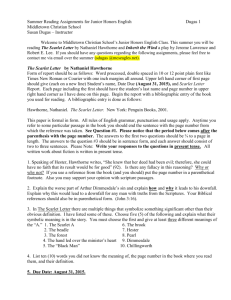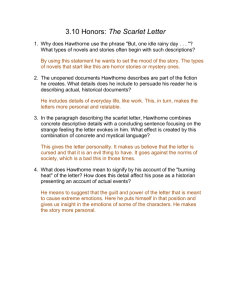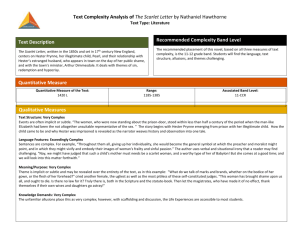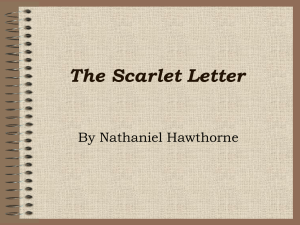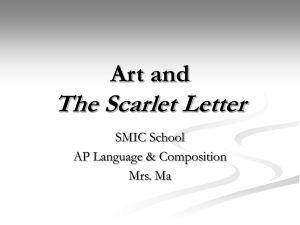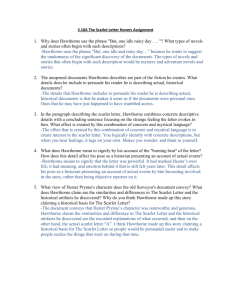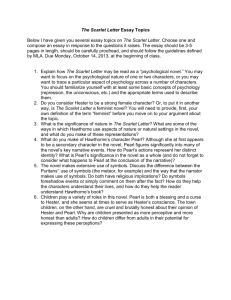The Scarlet Letter - Greer Middle College || Building the Future
advertisement
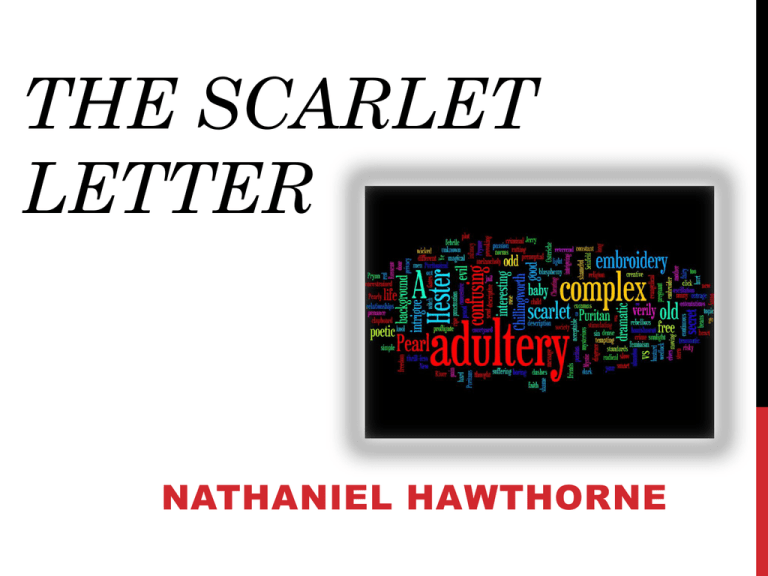
THE SCARLET LETTER NATHANIEL HAWTHORNE “I believe that The Scarlet Letter, like all great novels, enriches our sense of human experience and complicates and humanizes our approach to it.” from Solitude, Love, and Anguish: The Tragic Design of the Scarlet Letter by Seymour L. Gross HISTORICAL CONTEXT Boston Colony founded 1630 Recognized the Bible as the sole source of religious authority Maintained a theocracy Believed in predestination or Doctrine of the Elect Inflicted public punishments to deter others from straying from righteousness (hanging, whipping, humiliation, etc) NATHANIEL HAWTHORNE Hawthorne once said: “I do not want to be a doctor and live by man’s diseases, nor a minister to live by their sins, nor a lawyer and live by their quarrels. So, I don’t see that there is anything left for me but to be an author.” ABOUT THE AUTHOR •Born July 4, 1804 in Salem, Mass; died 1864 •Reclusive at times •Served as a magazine editor •Worked in the Salem Custom House •Lived at Brook Farmutopian society •Married Sophia Peabody and fathered Una (who became the model for Pearl) •Great-great-great-great grandfather, John Hathorne, was judge at Salem witch trials ABOUT THE NOVEL (PUB. 1840) • Hawthorne’s works reflect his dark vision of human nature, including his opinion of Puritanism as • cruel • obsessive • Intolerant • Largely psychological– why do people behave as they do • Conflict in the novel– mostly individual vs society PLOT/SETTING The novel is set in the mid 1600s in Boston, Massachusetts. The plot encompasses a seven year period. The plot involves the love triangle of wife-loverhusband. Settings throughout the novel are symbolic. POINT OF VIEW Third-Person Omniscient -Hawthorne reveals the inner and outer workings of the characters and provides social criticism, history, and psychology. CHARACTERS Hester Prynne- wearer of the scarlet letter Pearl- child of Hester; living symbol of Hester’s sin Roger Chillingworth- learned scholar; doctor Arthur Dimmesdale- admired young minister Governor Bellingham- governor and magistrate of Massachusetts Bay Colony Rev. John Wilson- senior minister of colony Mistress Hibbins- Gov. Bellingham’s sister MAJOR SYMBOL •The scarlet letter itself is the central symbol. •It changes meaning for the characters in the novel as Hester’s character changes. •The A becomes a pathway to redemption for some characters. •Watch the many ways Hawthorne uses the scarlet A as a symbol… MAJOR THEMES Hawthorne explains the historical, social, theological, and emotional/psychological ramifications of: • Sin • Concealment • Guilt • Love/hate THE CUSTOM HOUSE • 1st section (pp1-18)= people in CustomHouse • 2nd section (pp 1931)= how The Scarlet Letter comes about THE CUSTOM HOUSE (CONTENT) • Semi-autobiographical– narrator’s feelings toward family are the same as Hawthorne’s– he changed his last name to remove associations between him and Judge Hathorne (witch trials) • Custom house men were self-serving and/or unqualified • Primary 2 political parties: • Whigs • Democrats– narrator • Inspector= wealth; no heart/mind/soul • Collector= old General; distant; inappropriate environment • Pue wants narrator to write book telling Hester Prynne’s story IMPORTANT QUOTATIONS “…I happened to place [the old scarlet letter] on my breast. It seemed to me,—the reader may smile, but must not doubt my word,– it seemed to me, then, that I experienced a sensation not altogether physical, yet almost so, as of burning heat; and as if the letter were not of red cloth, but red-hot iron. I shuddered, and involuntarily let it fall upon the floor.” p 21 “With his own ghostly hand, the obscurely seen, but majestic, figure had imparted to me the scarlet symbol, and the little roll of explanatory manuscript. With his own ghostly voice, he had exhorted me, on the sacred consideration of my filial duty and reverence towards him– who might reasonably regard himself as my official ancestor– to bring his mouldy and moth-eaten lucubrations before the public.” p 23

